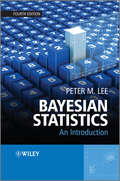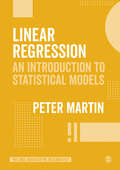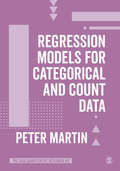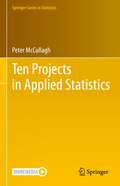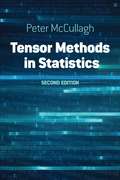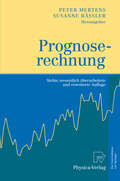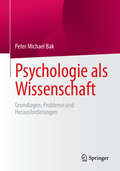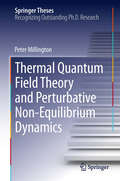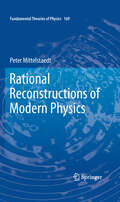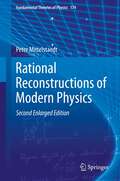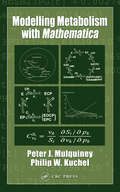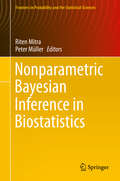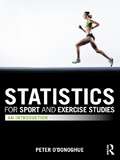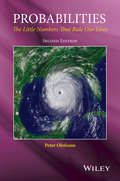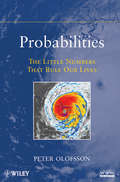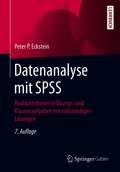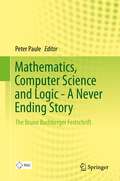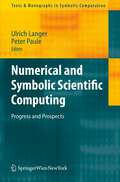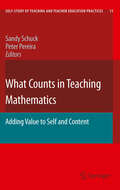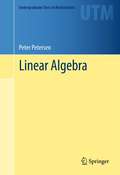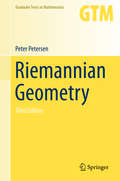- Table View
- List View
Bayesian Statistics
by Peter M. LeeBayesian Statistics is the school of thought that combines prior beliefs with the likelihood of a hypothesis to arrive at posterior beliefs. The first edition of Peter Lee's book appeared in 1989, but the subject has moved ever onwards, with increasing emphasis on Monte Carlo based techniques.This new fourth edition looks at recent techniques such as variational methods, Bayesian importance sampling, approximate Bayesian computation and Reversible Jump Markov Chain Monte Carlo (RJMCMC), providing a concise account of the way in which the Bayesian approach to statistics develops as well as how it contrasts with the conventional approach. The theory is built up step by step, and important notions such as sufficiency are brought out of a discussion of the salient features of specific examples.This edition:Includes expanded coverage of Gibbs sampling, including more numerical examples and treatments of OpenBUGS, R2WinBUGS and R2OpenBUGS.Presents significant new material on recent techniques such as Bayesian importance sampling, variational Bayes, Approximate Bayesian Computation (ABC) and Reversible Jump Markov Chain Monte Carlo (RJMCMC).Provides extensive examples throughout the book to complement the theory presented.Accompanied by a supporting website featuring new material and solutions.More and more students are realizing that they need to learn Bayesian statistics to meet their academic and professional goals. This book is best suited for use as a main text in courses on Bayesian statistics for third and fourth year undergraduates and postgraduate students.
Linear Regression: An Introduction to Statistical Models (The SAGE Quantitative Research Kit)
by Peter MartinThis text introduces the fundamental linear regression models used in quantitative research. It covers both the theory and application of these statistical models, and illustrates them with illuminating graphs. The author offers guidence on: Deciding the most appropriate model to use for your research Conducting simple and multiple linear regression Checking model assumptions and the dangers of overfitting Part of The SAGE Quantitative Research Kit, this book will help you make the crucial steps towards mastering multivariate analysis of social science data.
Linear Regression: An Introduction to Statistical Models (The SAGE Quantitative Research Kit)
by Peter MartinThis text introduces the fundamental linear regression models used in quantitative research. It covers both the theory and application of these statistical models, and illustrates them with illuminating graphs. The author offers guidence on: Deciding the most appropriate model to use for your research Conducting simple and multiple linear regression Checking model assumptions and the dangers of overfitting Part of The SAGE Quantitative Research Kit, this book will help you make the crucial steps towards mastering multivariate analysis of social science data.
Regression Models for Categorical and Count Data (The SAGE Quantitative Research Kit)
by Peter MartinThis text provides practical guidance on conducting regression analysis on categorical and count data. Step by step and supported by lots of helpful graphs, it covers both the theoretical underpinnings of these methods as well as their application, giving you the skills needed to apply them to your own research. It offers guidance on: · Using logistic regression models for binary, ordinal, and multinomial outcomes · Applying count regression, including Poisson, negative binomial, and zero-inflated models · Choosing the most appropriate model to use for your research · The general principles of good statistical modelling in practice Part of The SAGE Quantitative Research Kit, this book will give you the know-how and confidence needed to succeed on your quantitative research journey
Regression Models for Categorical and Count Data (The SAGE Quantitative Research Kit)
by Peter MartinThis text provides practical guidance on conducting regression analysis on categorical and count data. Step by step and supported by lots of helpful graphs, it covers both the theoretical underpinnings of these methods as well as their application, giving you the skills needed to apply them to your own research. It offers guidance on: · Using logistic regression models for binary, ordinal, and multinomial outcomes · Applying count regression, including Poisson, negative binomial, and zero-inflated models · Choosing the most appropriate model to use for your research · The general principles of good statistical modelling in practice Part of The SAGE Quantitative Research Kit, this book will give you the know-how and confidence needed to succeed on your quantitative research journey
Ten Projects in Applied Statistics (Springer Series in Statistics)
by Peter McCullaghThe first half of the book is aimed at quantitative research workers in biology, medicine, ecology and genetics. The book as a whole is aimed at graduate students in statistics, biostatistics, and other quantitative disciplines. Ten detailed examples show how the author approaches real-world statistical problems in a principled way that allows for adequate compromise and flexibility. The need to accommodate correlations associated with space, time and other relationships is a recurring theme, so variance-components models feature prominently. Statistical pitfalls are illustrated via examples taken from the recent scientific literature. Chapter 11 sets the scene, not just for the second half of the book, but for the book as a whole. It begins by defining fundamental concepts such as baseline, observational unit, experimental unit, covariates and relationships, randomization, treatment assignment, and the role that these play in model formulation. Compatibility of the model with the randomization scheme is crucial. The effect of treatment is invariably modelled as a group action on probability distributions. Technical matters connected with space-time covariance functions, residual likelihood, likelihood ratios, and transformations are discussed in later chapters.
Tensor Methods in Statistics: Second Edition
by Peter McCullaghA pioneering monograph on tensor methods applied to distributional problems arising in statistics, this work constitutes a valuable reference for graduate students and professional statisticians. Prerequisites include some knowledge of linear algebra, eigenvalue decompositions, and linear models as well as likelihood functions and likelihood ratio statistics. Index notation is the favored mode of expression throughout the book. The first chapter introduces a number of aspects of index notation, groups, invariants, and tensor calculus, with examples drawn from linear algebra, physics, and statistics. Subsequent chapters form the core of the text, addressing moments, cumulants, and invariants. Additional topics include sample cumulants, Edgeworth series, saddlepoint approximation, likelihood functions, and ancillary statistics. More than 200 exercises form an integral part of the text.
Prognoserechnung
by Peter Mertens Susanne RässlerMit diesem Buch liegen kompakte Beschreibungen von Prognoseverfahren vor, die vor allem in Systemen der betrieblichen Informationsverarbeitung eingesetzt werden. Praktiker mit langjähriger Prognoseerfahrung zeigen außerdem, wie die einzelnen Methoden in der Unternehmung Verwendung finden und wo die Probleme beim Einsatz liegen. Das Buch wendet sich gleichermaßen an Wissenschaft und Praxis. Das Spektrum reicht von einfachen Verfahren der Vorhersage über neuere Ansätze der künstlichen Intelligenz und Zeitreihenanalyse bis hin zur Prognose von Softwarezuverlässigkeit und zur kooperativen Vorhersage in Liefernetzen. In der siebenten, wesentlich überarbeiteten und erweiterten Auflage werden neue Vergleiche von Prognosemethoden, GARCH-Modelle zur Finanzmarktprognose, "Predictive Analytics" als Variante der "Business Intelligence" und die Kombination von Vorhersagen mit Elementen der Chaostheorie berücksichtigt.
Psychologie als Wissenschaft: Grundlagen, Probleme und Herausforderungen
by Peter Michael BakDieses Buch widmet sich der Psychologie als Wissenschaft. Die Psychologie hat sich zwar längst als Wissenschaft etabliert, dennoch sind noch viele grundlegende Fragen in Bezug auf den Untersuchungsgegenstand und die wissenschaftliche Herangehensweise offen. Es geht um Fragen wie: Kann man die Psychologie wie eine Naturwissenschaft betreiben oder entzieht sich menschliches Verhalten und Erleben einer solchen Herangehensweise? Wie versucht die Psychologie ihre wissenschaftlichen Ziele zu erreichen? Was verstehen wir eigentlich unter Beschreiben, Erklären oder Vorhersagen in der Psychologie? Und was können wir unter psychologischen Theorien, Hypothesen und Prüfungen genau verstehen? Welche aktuellen Probleme behindern den wissenschaftlichen Fortschritt und was kann man dagegen unternehmen? Ohne auf solche Fragen eine Antwort geben zu können, kann man Psychologie als Wissenschaft nicht wirklich betreiben. Aber auch die psychologische Anwendungspraxis muss darauf Antworten finden, wenn es beispielsweise darum geht, Interventionen zu rechtfertigen und zu begründen. Das Buch gibt zu diesen Fragen einen Überblick, benennt Probleme und Schwierigkeiten der Wissenschaft Psychologie und gibt Anregungen, wie man die Psychologie wissenschaftlich weiterentwickeln kann.
Thermal Quantum Field Theory and Perturbative Non-Equilibrium Dynamics
by Peter MillingtonThe author develops a new perturbative formalism of non-equilibrium thermal quantum field theory for non-homogeneous backgrounds. As a result of this formulation, the author is able to show how so-called pinch singularities can be removed, without resorting to ad hoc prescriptions, or effective resummations of absorptive effects. Thus, the author arrives at a diagrammatic approach to non-equilibrium field theory, built from modified Feynman rules that are manifestly time-dependent from tree level. This new formulation provides an alternative framework in which to derive master time evolution equations for physically meaningful particle number densities, which are valid to all orders in perturbation theory and to all orders in gradient expansion. Once truncated in a loop-wise sense, these evolution equations capture non-equilibrium dynamics on all time-scales, systematically describing energy-violating processes and the non-Markovian evolution of memory effects
Rational Reconstructions of Modern Physics
by Peter MittelstaedtNewton’s classical physics and its underlying ontology are loaded with several metaphysical hypotheses that cannot be justified by rational reasoning nor by experimental evidence. Furthermore, it is well known that some of these hypotheses are not contained in the great theories of modern physics, such as the theory of relativity and quantum mechanics. This book shows that, on the basis of Newton’s classical physics and by rational reconstruction, the theory of relativity as well as quantum mechanics can be obtained by partly eliminating or attenuating the metaphysical hypotheses. Moreover, it is shown that these reconstructions do not require additional hypotheses or new experimental results.
Rational Reconstructions of Modern Physics, 2nd Enlarged Edition
by Peter MittelstaedtNewton's classical physics and its underlying ontology are loaded with several metaphysical hypotheses that cannot be justified by rational reasoning nor by experimental evidence. Furthermore, it is well known that some of these hypotheses are not contained in the great theories of Modern Physics, such as the theory of Special Relativity and Quantum Mechanics. This book shows that, on the basis of Newton's classical physics and by rational reconstruction, the theory of Special Relativity as well as Quantum Mechanics can be obtained by partly eliminating or attenuating the metaphysical hypotheses. Moreover, it is shown that these reconstructions do not require additional hypotheses or new experimental results. <P><P> In the second edition the rational reconstructions are completed with respect to General Relativity and Cosmology. In addition, the statistics of quantum objects is elaborated in more detail with respect to the rational reconstruction of quantum mechanics. The new material completes the approach of the book as much as it is possible at the present state of knowledge. Presumably, the most important contribution that is added to the second edition refers to the problem of interpretation of the three great theories of Modern Physics. It is shown in detail that in the light of rational reconstructions even realistic interpretations of the three theories of Modern Physics are possible and can easily be achieved.
Modelling Metabolism with Mathematica
by Peter Mulquiney Philip W. KuchelWith the advent of sophisticated general programming environments like Mathematica, the task of developing new models of metabolism and visualizing their responses has become accessible to students of biochemistry and the life sciences in general. Modelling Metabolism with Mathematica presents the approaches, methods, tools, and algorithms for mode
Nonparametric Bayesian Inference in Biostatistics
by Peter Müller Riten MitraAs chapters in this book demonstrate, BNP has important uses in clinical sciences and inference for issues like unknown partitions in genomics. Nonparametric Bayesian approaches (BNP) play an ever expanding role in biostatistical inference from use in proteomics to clinical trials. Many research problems involve an abundance of data and require flexible and complex probability models beyond the traditional parametric approaches. As this book's expert contributors show, BNP approaches can be the answer. Survival Analysis, in particular survival regression, has traditionally used BNP, but BNP's potential is now very broad. This applies to important tasks like arrangement of patients into clinically meaningful subpopulations and segmenting the genome into functionally distinct regions. This book is designed to both review and introduce application areas for BNP. While existing books provide theoretical foundations, this book connects theory to practice through engaging examples and research questions. Chapters cover: clinical trials, spatial inference, proteomics, genomics, clustering, survival analysis and ROC curve.
Wavelets: A Student Guide
by Peter NickolasThis text offers an excellent introduction to the mathematical theory of wavelets for senior undergraduate students. Despite the fact that this theory is intrinsically advanced, the author's elementary approach makes it accessible at the undergraduate level. Beginning with thorough accounts of inner product spaces and Hilbert spaces, the book then shifts its focus to wavelets specifically, starting with the Haar wavelet, broadening to wavelets in general, and culminating in the construction of the Daubechies wavelets. All of this is done using only elementary methods, bypassing the use of the Fourier integral transform. Arguments using the Fourier transform are introduced in the final chapter, and this less elementary approach is used to outline a second and quite different construction of the Daubechies wavelets. The main text of the book is supplemented by more than 200 exercises ranging in difficulty and complexity.
Statistics for Sport and Exercise Studies: An Introduction
by Peter O'DonoghueStatistics for Sport and Exercise Studies guides the student through the full research process, from selecting the most appropriate statistical procedure, to analysing data, to the presentation of results, illustrating every key step in the process with clear examples, case-studies and data taken from real sport and exercise settings. Every chapter includes a range of features designed to help the student grasp the underlying concepts and relate each statistical procedure to their own research project, including definitions of key terms, practical exercises, worked examples and clear summaries. The book also offers an in-depth and practical guide to using SPSS in sport and exercise research, the most commonly used data analysis software in sport and exercise departments. In addition, a companion website includes more than 100 downloadable data sets and work sheets for use in or out of the classroom, full solutions to exercises contained in the book, plus over 1,300 PowerPoint slides for use by tutors and lecturers. Statistics for Sport and Exercise Studies is a complete, user-friendly introduction to the use of statistical tests, techniques and procedures in sport, exercise and related subjects. Visit the companion website at: www.routledge.com/cw/odonoghue
Probabilities
by Peter OlofssonPraise for the First Edition"If there is anything you want to know, or remind yourself, about probabilities, then look no further than this comprehensive, yet wittily written and enjoyable, compendium of how to apply probability calculations in real-world situations."- Keith Devlin, Stanford University, National Public Radio's "Math Guy" and author of The Math Gene and The Unfinished GameFrom probable improbabilities to regular irregularities, Probabilities: The Little Numbers That Rule Our Lives, Second Edition investigates the often surprising effects of risk and chance in our lives. Featuring a timely update, the Second Edition continues to be the go-to guidebook for an entertaining presentation on the mathematics of chance and uncertainty. The new edition develops the fundamental mathematics of probability in a unique, clear, and informal way so readers with various levels of experience with probability can understand the little numbers found in everyday life. Illustrating the concepts of probability through relevant and engaging real-world applications, the Second Edition features numerous examples on weather forecasts, DNA evidence, games and gambling, and medical testing. The revised edition also includes:The application of probability in finance, such as option pricingThe introduction of branching processes and the extinction of family namesAn extended discussion on opinion polls and Nate Silver's election predictionsProbabilities: The Little Numbers That Rule Our Lives, Second Edition is an ideal reference for anyone who would like to obtain a better understanding of the mathematics of chance, as well as a useful supplementary textbook for students in any course dealing with probability.
Probabilities: The Little Numbers That Rule Our Lives
by Peter OlofssonWhat are the chances? Find out in this entertaining exploration ofprobabilities in our everyday lives “If there is anything you want to know, or remind yourself, about probabilities, then look no further than this comprehensive, yet wittily written and enjoyable, compendium of how to apply probability calculations in real-world situations.” — Keith Devlin, Stanford University, National Public Radio’s “Math Guy” and author of The Math Gene and The Math Instinct “A delightful guide to the sometimes counterintuitive discipline of probability. Olofsson points out major ideas here, explains classic puzzles there, and everywhere makes free use of witty vignettes to instruct and amuse.” — John Allen Paulos, Temple University, author of Innumeracy and A Mathematician Reads the Newspaper “Beautifully written, with fascinating examples and tidbits of information. Olofsson gently and persuasively shows us how to think clearly about the uncertainty that governs our lives.” — John Haigh, University of Sussex, author of Taking Chances: Winning with Probability From probable improbabilities to regular irregularities, Probabilities: The Little Numbers That Rule Our Lives investigates the often-surprising effects of risk and chance in our everyday lives. With examples ranging from WWII espionage to the O. J. Simpson trial, from bridge to blackjack, from Julius Caesar to Jerry Seinfeld, the reader is taught how to think straight in a world of randomness and uncertainty. Throughout the book, readers learn: Why it is not that surprising for someone to win the lottery twice How a faulty probability calculation forced an innocent woman to spend three years in prison How to place bets if you absolutely insist on gambling How a newspaper turned an opinion poll into one of the greatest election blunders in history Educational, eloquent, and entertaining, Probabilities: The Little Numbers That Rule Our Lives is the ideal companion for anyone who wants to obtain a better understanding of the mathematics of chance.
Datenanalyse mit SPSS: Realdatenbasierte Übungs- und Klausuraufgaben mit vollständigen Lösungen
by Peter P. EcksteinPeter P. Eckstein bietet in diesem Lehrbuch eine Vielzahl von Übungs- und Klausuraufgaben zur statistischen Datenanalyse mit SPSS an. Die Aufgaben sind nach inhaltlichen Schwerpunkten geordnet und decken jedes Anspruchsniveau ab. Basis sind reale Daten, die im Kontext von praktischen Problemstellungen der empirischen Wirtschafts- und Sozialforschung erhoben wurden. Vollständige und ausführliche Lösungen zu allen Aufgaben führen zu einer hohen Verständlichkeit des komplexen Stoffes und ermöglichen somit ein effektives Selbststudium und eine gezielte Klausurvorbereitung.Für die siebte Auflage wurde das Aufgabenspektrum auf insgesamt 195 komplexe Problemstellungen mit zahlreichen theoretischen und praktischen Fragen erweitert. Alle in diesem Lehrbuch verwendeten SPSS-Dateien sind im Anhang aufgelistet und stehen im Internet zur freien Verfügung bereit.
Prospect Theory
by Peter P. WakkerProspect Theory: For Risk and Ambiguity provides the first comprehensive and accessible textbook treatment of the way decisions are made both when we have the statistical probabilities associated with uncertain future events (risk) and when we lack them (ambiguity). The book presents models, primarily prospect theory, that are both tractable and psychologically realistic. A method of presentation is chosen that makes the empirical meaning of each theoretical model completely transparent. Prospect theory has many applications in a wide variety of disciplines. The material in the book has been carefully organized to allow readers to select pathways through the book relevant to their own interests. With numerous exercises and worked examples, the book is ideally suited to the needs of students taking courses in decision theory in economics, mathematics, finance, psychology, management science, health, computer science, Bayesian statistics, and engineering.
Mathematics, Computer Science and Logic - A Never Ending Story
by Peter PauleThis book presents four mathematical essays which explore the foundations of mathematics and related topics ranging from philosophy and logic to modern computer mathematics. While connected to the historical evolution of these concepts, the essays place strong emphasis on developments still to come The book originated in a 2002 symposium celebrating the work of Bruno Buchberger, Professor of Computer Mathematics at Johannes Kepler University, Linz, Austria, on the occasion of his 60th birthday. Among many other accomplishments, Professor Buchberger in 1985 was the founding editor of the Journal of Symbolic Computation; the founder of the Research Institute for Symbolic Computation (RISC) and its chairman from 1987-2000; the founder in 1990 of the Softwarepark Hagenberg, Austria, and since then its director More than a decade in the making, Mathematics, Computer Science and Logic - A Never Ending Story includes essays by leading authorities, on such topics as mathematical foundations from the perspective of computer verification; a symbolic-computational philosophy and methodology for mathematics; the role of logic and algebra in software engineering; and new directions in the foundations of mathematics. These inspiring essays invite general, mathematically interested readers to share state-of-the-art ideas which advance the never ending story of mathematics, computer science and logic Mathematics, Computer Science and Logic - A Never Ending Story is edited by Professor Peter Paule, Bruno Buchberger's successor as director of the Research Institute for Symbolic Computation.
Numerical and Symbolic Scientific Computing: Progress and Prospects
by Peter Paule Ulrich LangerThe book presents the state of the art and results and also includes articles pointing to future developments. Most of the articles center around the theme of linear partial differential equations. Major aspects are fast solvers in elastoplasticity, symbolic analysis for boundary problems, symbolic treatment of operators, computer algebra, and finite element methods, a symbolic approach to finite difference schemes, cylindrical algebraic decomposition and local Fourier analysis, and white noise analysis for stochastic partial differential equations. Further numerical-symbolic topics range from applied and computational geometry to computer algebra methods used for total variation energy minimization.
What Counts in Teaching Mathematics
by Sandy Schuck Peter PereiraIn this book, internationally recognised scholars and practitioners synthesise current practice and research developments in the area of mathematics teacher education and mathematics education. The book's two sections examine the role and significance of collaborations and critical friends in the self-study of mathematics teaching and teacher education; and the emerging conflicts, dilemmas and incongruities arising from the study of mathematics education practices. The book considers the insights gained from self-analysis regarding the practitioner themselves, as well as their pedagogical content, students and approaches. The contributions highlight the complexity, characteristics and features of mathematics education. The chapters reveal nuances in teaching and learning that are of particular relevance in mathematics education. In addition, the book contains ideas and suggestions on how to enhance the teaching of mathematical content to pre-service teachers. Accordingly, the book appeals to a wide audience of educators--including education academics, teachers, student teachers and researchers. As teacher educators involved in mathematics education, reflection on practice and engagement in practitioner research is becoming increasingly important in our efforts to enhance our teaching. Teachers and student teachers also gain from the insights arising from such reflection. The knowledge and experience encapsulated in this book provides much for the mathematics education community to build on.
Linear Algebra
by Peter PetersenThis textbook on linear algebra includes the key topics of the subject that most advanced undergraduates need to learn before entering graduate school. All the usual topics, such as complex vector spaces, complex inner products, the Spectral theorem for normal operators, dual spaces, the minimal polynomial, the Jordan canonical form, and the rational canonical form, are covered, along with a chapter on determinants at the end of the book. In addition, there is material throughout the text on linear differential equations and how it integrates with all of the important concepts in linear algebra. This book has several distinguishing features that set it apart from other linear algebra texts. For example: Gaussian elimination is used as the key tool in getting at eigenvalues; it takes an essentially determinant-free approach to linear algebra; and systems of linear differential equations are used as frequent motivation for the reader. Another motivating aspect of the book is the excellent and engaging exercises that abound in this text. This textbook is written for an upper-division undergraduate course on Linear Algebra. The prerequisites for this book are a familiarity with basic matrix algebra and elementary calculus, although any student who is willing to think abstractly should not have too much difficulty in understanding this text.
Riemannian Geometry
by Peter PetersenIntended for a one year course, this text serves as a single source, introducing readers to the important techniques and theorems, while also containing enough background on advanced topics to appeal to those students wishing to specialize in Riemannian geometry. This is one of the few Works to combine both the geometric parts of Riemannian geometry and the analytic aspects of the theory. The book will appeal to a readership that have a basic knowledge of standard manifold theory, including tensors, forms, and Lie groups. Important revisions to the third edition include: a substantial addition of unique and enriching exercises scattered throughout the text; inclusion of an increased number of coordinate calculations of connection and curvature; addition of general formulas for curvature on Lie Groups and submersions; integration of variational calculus into the text allowing for an early treatment of the Sphere theorem using a proof by Berger; incorporation of several recent results about manifolds with positive curvature; presentation of a new simplifying approach to the Bochner technique for tensors with application to bound topological quantities with general lower curvature bounds. From reviews of the first edition: "The book can be highly recommended to all mathematicians who want to get a more profound idea about the most interesting achievements in Riemannian geometry. It is one of the few comprehensive sources of this type. " ―Bernd Wegner, ZbMATH
